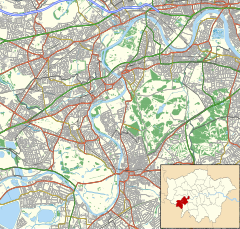| Richmond Palace | |
|---|---|
 Richmond Palace, west front, drawn by Antony Wyngaerde, dated 1562 | |
Shown in Richmond upon Thames | |
| General information | |
| Coordinates | 51°27′40″N 0°18′32″W / 51.46117°N 0.30888°W |
| Destroyed | 1649–1659 |
Richmond Palace was a Tudor royal residence on the River Thames in England which stood in the sixteenth and seventeenth centuries. Situated in what was then rural Surrey, it lay upstream and on the opposite bank from the Palace of Westminster, which was located nine miles (14 km) to the north-east. It was erected in about 1501 by Henry VII of England, formerly known as the Earl of Richmond, in honour of which the manor of Sheen had recently been renamed "Richmond". Richmond Palace therefore replaced Shene Palace, the latter palace being itself built on the site of an earlier manor house which had been appropriated by Edward I in 1299 and which was subsequently used by his next three direct descendants before it fell into disrepair.
In 1500, a year before the construction of the new Richmond Palace began, the name of the town of Sheen, which had grown up around the royal manor, was changed to "Richmond" by command of Henry VII.[1] However, both names, Sheen and Richmond, continue to be used, not without scope for confusion. Curiously, today's districts of East Sheen and North Sheen, now under the administrative control of the London Borough of Richmond upon Thames, were never in ancient times within the manor of Sheen, but were rather developed during the 19th and 20th centuries in parts of the adjoining manor and parish of Mortlake. Richmond remained part of the County of Surrey until April 1, 1965, when it was absorbed by the expansion of Greater London as a result of the London Government Act 1963.
Richmond Palace was a favourite home of Queen Elizabeth I, who died there in 1603. It remained a residence of the kings and queens of England until the death of Charles I of England in 1649. Within months of his execution, the Palace was surveyed by order of the Parliament of England and was sold for £13,000. Over the following ten years it was largely demolished, the stones and timbers being re-used as building materials elsewhere. Only vestigial traces now survive, notably the Gate House.[2] (51°27'41"N 0°18'33"W). The site of the former palace is the area between Richmond Green and the River Thames, and some local street names provide clues to existence of the former Palace, including Old Palace Lane and Old Palace Yard.
- ^ "Richmond", in Encyclopædia Britannica, (9th edition, 1881), s.v.
- ^ Cite error: The named reference
Gate House listingwas invoked but never defined (see the help page).
